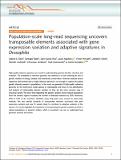Por favor, use este identificador para citar o enlazar a este item:
http://hdl.handle.net/10261/272269COMPARTIR / EXPORTAR:
 SHARE SHARE
 CORE
BASE CORE
BASE
|
|
| Visualizar otros formatos: MARC | Dublin Core | RDF | ORE | MODS | METS | DIDL | DATACITE | |

| Título: | Population-scale long-read sequencing uncovers transposable elements associated with gene expression variation and adaptive signatures in Drosophila |
Autor: | Rech, Gabriel E. CSIC ORCID; Radío, Santiago CSIC; Guirao-Rico, Sara CSIC ORCID; Aguilera, Laura CSIC ORCID; Horváth, Vivien CSIC ORCID; Green, Llewellyn; Lindstadt, Hannah; Jamilloux, Véronique; Quesneville, Hadi; González Pérez, Josefa CSIC ORCID | Fecha de publicación: | 12-abr-2022 | Editor: | Springer Nature | Citación: | Nature Communications 13: 1948 (2022) | Resumen: | High quality reference genomes are crucial to understanding genome function, structure and evolution. The availability of reference genomes has allowed us to start inferring the role of genetic variation in biology, disease, and biodiversity conservation. However, analyses across organisms demonstrate that a single reference genome is not enough to capture the global genetic diversity present in populations. In this work, we generate 32 high-quality reference genomes for the well-known model species D. melanogaster and focus on the identification and analysis of transposable element variation as they are the most common type of structural variant. We show that integrating the genetic variation across natural populations from five climatic regions increases the number of detected insertions by 58%. Moreover, 26% to 57% of the insertions identified using long-reads were missed by short-reads methods. We also identify hundreds of transposable elements associated with gene expression variation and new TE variants likely to contribute to adaptive evolution in this species. Our results highlight the importance of incorporating the genetic variation present in natural populations to genomic studies, which is essential if we are to understand how genomes function and evolve. | Versión del editor: | https://doi.org/10.1038/s41467-022-29518-8 | URI: | http://hdl.handle.net/10261/272269 | DOI: | 10.1038/s41467-022-29518-8 | E-ISSN: | 2041-1723 |
| Aparece en las colecciones: | (IBE) Artículos |
Ficheros en este ítem:
| Fichero | Descripción | Tamaño | Formato | |
|---|---|---|---|---|
| signatures_Drosophila.pdf | 35,38 MB | Adobe PDF |  Visualizar/Abrir |
CORE Recommender
SCOPUSTM
Citations
34
checked on 05-may-2024
WEB OF SCIENCETM
Citations
25
checked on 26-feb-2024
Page view(s)
39
checked on 06-may-2024
Download(s)
46
checked on 06-may-2024
Google ScholarTM
Check
Altmetric
Altmetric
Este item está licenciado bajo una Licencia Creative Commons

